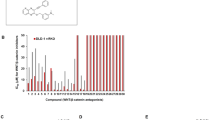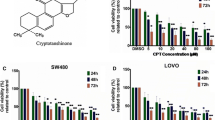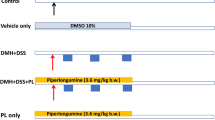Abstract
This study was designed to investigate whether indomethacin and NGX6 synergistically inhibit the growth and invasiveness of human colon cancer cells (HT-29 and SW620) and to elucidate the molecular mechanism of their action. Cell proliferation was assessed by MTT assay. Cell apoptosis was assessed by acridine orange/ethidium bromide staining (AO–EB) and annexin-V-FITC/PI assay. Invasive behaviors of colorectal cancer cells were examined by cell adhesion, migration, and invasion assays. Gap junctional intercellular communication (GJIC) was assessed by the scrape-loading/dye transfer technique. The subcellular localization and expression of β-catenin protein was examined by immunofluorescence staining and western blot analysis, respectively. Indomethacin and NGX6 had a synergistic effect on inhibiting proliferation and invasiveness of colon cancer HT-29 and SW620 cells, restoring GJIC of HT-29 and SW620, and suppressing translocation of β-catenin from the nucleus and cytoplasm to the plasma membrane. However, they did not have synergistic effects on enhancing apoptosis and suppressing extracellular matrix adhesion of HT-29 and SW620 cells. Indomethacin and NGX6 inhibit the proliferation and invasiveness of HT-29 and SW620 colon cancer cells by attenuating the WNT/ß-catenin signaling pathway.








Similar content being viewed by others
References
Toribara NW, Kim YS (1992) Premalignancy and malignancy of the colon. In: Sleisenger M, Fordtran J (eds) Gastrointestinal disease. WB Saunders, Philadelphia, pp 1–2
Cohen AM, Minsdy BD, Friedman MA (1993) Rectal cancer. In: DeVita V, Hellman S, Rosenberg S (eds) Cancer: principles and practice of oncology. Lippincott, Philadelphia, pp 978–1005
Ma J, Zhou J, Fan S, Wang L, Li X, Yan Q, Zhou M, Liu H, Zhang Q, Zhou H, Gan K, Li Z, Peng C, Xiong W, Tan C, Shen S, Yang J, Li J, Li G (2005) Role of a novel EGF-like domain-containing gene NGX6 in cell adhesion modulation in nasopharyngeal carcinoma cells. Carcinogenesis 26:281–291. doi:10.1093/carcin/bgh312
Wang L, Ma J, Li J et al (2005) NGX6 gene inhibits cell proliferation and plays a negative role in EGFR pathway in nasopharyngeal carcinoma cells. J Cell Biochem 95:64–73. doi:10.1002/jcb.20393
WangX Y, Shen S, Liu HY et al (2004) The effect of NGX6 on cell biology. World Chin J Dig 12:574–579
Liu F, Shen SR, Li HT, Wang XY, Peng Y, Liao MT, Guo Q (2007) Effects of NGX6 on the transcriptional activation of beta-catenin/TCF/LEF in Wnt/beta-catenin signal pathway]. Zhong Nan Da Xue Xue Bao Yi Xue Ban 32(6):985–991
Wang HM, Zhang GY (2005) Indomethacin suppresses growth of colon cancer via inhibition of angiogenesis in vivo. World J Gastroenterol 11:340–343
Shiff SJ, Koutsos MI, Qiao L, Rigas B (1996) Nonsteroidal antiinflammatory drugs inhibit the proliferation of colon adenocarcinoma cells: effects on cell cycle and apoptosis. Exp Cell Res 222:179–188. doi:10.1006/excr.1996.0023
Yoshimi N, Kawabata K, Hara A, Matsunaga K, Yamada Y, Mori H (1997) Inhibitory effect of NS-398, a selective cyclooxygenase-2 inhibitor, on azoxymethane-induced aberrant crypt foci in colon carcinogenesis of F344 rats. Jpn J Cancer Res 88:1044–1051
Smith ML, Hawcroft G, Hull MA (2000) The effect of non-steroidal anti-inflammatory drugs on human colorectal cancer cells: evidence of different mechanisms of action. Eur J Cancer 36:664–674
Hull MA, Gardner SH, Hawcroft G (2003) Activity of the non-steroidal anti-inflammatory drug indomethacin against colorectal cancer. Cancer Treat Rev 29:309–320. doi:10.1016/S0305-7372(03)00014-8
Wu M, Huang C, Gan K, Huang H, Chen Q, Ouyang J, Tang Y, Li X, Yang Y, Zhou H, Zhou Y, Zeng Z, Xiao L, Li D, Tang K, Shen S, Li G (2006) LRRC4, a putative tumor suppressor gene, requires a functional leucine-rich repeat cassette domain to inhibit proliferation of glioma cells in vitro by modulating the extracellular signal-regulated kinase/protein kinase B/nuclear factor-{kappa}B pathway. Mol Biol Cell 17:3534–3542. doi:10.1091/mbc.E05-11-1082
Busk M, Pytela R, Sheppard D (1992) Characterization of the integrin alpha v beta 6 as a fibronectin-binding protein. J Biol Chem 267:5790–5796
Wu M, Gan K, Huang C, Tang Y, Chen Q, Tang K, Li X, Shen S, Li G (2006) LRRC4 controls in vitro invasion of glioblastoma cells through inhibiting RPTP-zeta expression. J Neurooncol 80:133–142. doi:10.1007/s11060-006-9173-6
Dihlmann S, Klein S, von Knebel Doeberitz M (2003) Reduction of ß-catenin/T-cell transcription factor signaling by aspirin and indomethacin is caused by an increased stabilization of phosphorylated ß-catenin. Mol Cancer Ther 2:509–516
Fuchs SY, Ougolkov AV, Spiegelman VS, Minamoto T (2005) Oncogenic beta-catenin signaling networks in colorectal cancer. Cell Cycle 4:1522–1539
Bremnes RM, Veve R, Gabrielson E et al (2002) High-throughput tissue microarray analysis used to evaluate biology and prognostic significance of the E-cadherin pathway in non-small-cell lung cancer. J Clin Oncol 20(10):2417–2428. doi:10.1200/JCO.2002.08.159
Peng S, Fan S, Li X, Wang L et al (2007) The expression of ezrin in NPC and its interaction with NGX6, a novel candidate suppressor. Cancer Sci 98(3):341–349. doi:10.1111/j.1349-7006.2007.00410.x
Elzagheid A, Korkeila E, Bendardaf R, Buhmeida A, Heikkilä S, Vaheri A, Syrjänen K, Pyrhönen S, Carpén O (2008) Intense cytoplasmic ezrin immunoreactivity predicts poor survival in colorectal cancer. Hum Pathol 39(12):1737–1743. doi:10.1016/j.humpath.2008.04.020
Acknowledgments
We gratefully acknowledge for the financial assistance granted by the State Key Science Research Program of China (2006CB910503); the National Natural Science Foundation of China (30770972, 30770825); China Postdoctoral Science Foundation (20060400265); the Hunan Province Natural Sciences Foundations of China (06JJ20068, 07JJ3057); Research Fund for the Doctoral Program of Higher Education of China (20070533031)
Author information
Authors and Affiliations
Corresponding author
Rights and permissions
About this article
Cite this article
Guo, Q., Wu, M., Lian, P. et al. Synergistic effect of indomethacin and NGX6 on proliferation and invasion by human colorectal cancer cells through modulation of the Wnt/β-catenin signaling pathway. Mol Cell Biochem 330, 71–81 (2009). https://doi.org/10.1007/s11010-009-0102-9
Received:
Accepted:
Published:
Issue Date:
DOI: https://doi.org/10.1007/s11010-009-0102-9




